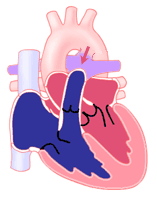How is Patent Ductus Arteriosus Treated?
In a newborn, the patent ductus arteriosus still has the chance to close on its own. Your doctor may allow more time for the patent ductus arteriosus to close if their heart failure is under control. If a newborn’s symptoms are severe or it is unlikely to close on its own, medical or surgical treatment is needed.
Medicines work best for newborns. They may receive medicine, such as indomethacin or ibuprofen, to constrict the muscle in the wall of the patent ductus arteriosus and help it close. These drugs do have side effects, so not all babies can receive them.
Closing the patent ductus arteriosus is a more common option for older infants and children. This includes surgery or closing the PDA in the cardiac catheterization laboratory with a device or coil.
During the cardiac catheterization procedure:
- Your child is either sedated or placed under general anesthesia, depending on their age.
- Catheters are placed into blood vessels in the groin and threaded up the aorta (a large blood vessel), stopping close to the ductus arteriosus.
- A picture (called an angiogram) is taken to define the shape and size of the ductus arteriosus.
- If the ductus is small, the doctor may place a coil within the vessel. For larger openings, the doctor may use a plug-shaped device to block the vessel.
A child, at any age, can have surgery to close the patent ductus arteriosus. Surgery is the best option for a child who has a very large patent ductus arteriosus or other unusual anatomy.
If your child has surgery:
- A small incision is made between the ribs on the left side.
- The ductus arteriosus is tied and cut.
The risk of complications with any of these treatments is low, determined mostly by how ill the child is prior to treatment.
Is Patent Ductus Arteriosus Ever a GOOD Thing?
Yes, in some cases. Some babies have heart defects that require the patent ductus arteriosus to remain open for them to survive.
In some heart defects, such as pulmonary atresia (an underdeveloped or blocked pulmonary valve), the patent ductus arteriosus supplies the only adequate source of blood flow to the lungs so that oxygen can be delivered to the blood. In these patients, the ductus arteriosus supplies blood to the lungs from the aorta.
In other defects, such as underdeveloped or severely narrowed aorta (like that seen in hypoplastic left heart syndrome), the patent ductus arteriosus is crucial to allow adequate blood flow to the body. The ductus arteriosus supplies blood to the body from the pulmonary artery.
In these cases, medicine is given, and the baby is watched closely in the intensive care unit. Keeping the patent ductus arteriosus open using this medicine allows time for the newborn to become stable until other treatments, usually surgery, are done.





